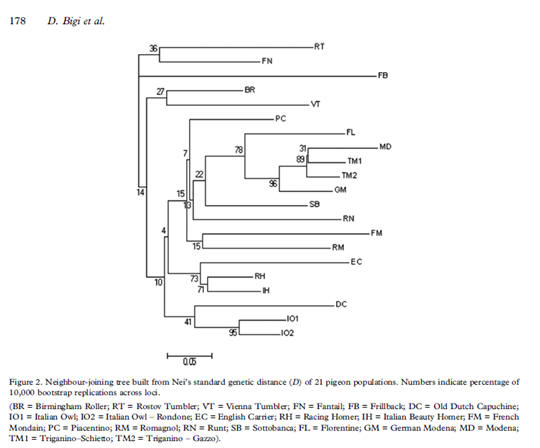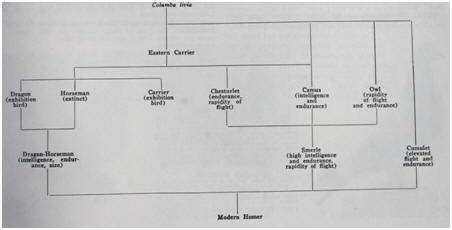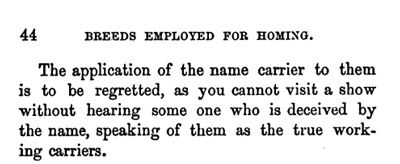|
Genetic Investigation of Italian Domestic Pigeons
D. Bigi
(University of Bologna) et al,
'Genetic investigation of Italian domestic
pigeons increases knowledge about the long-bred history of
Columba livia (Aves: Columbidae)'
Italian Journal of
Zoology, 2016, 173-182, Vol. 73, No. 2, http://www.tandfonline.com/doi/full/10.1080/11250003.2016.1172121
In a study published in
2016, an Italian research group investigated the relationships
between eight Italian and eleven foreign breeds, two of the Italians
being subdivided into subgroups (Fig. 1). Not very well known abroad
are the Italian breeds Piacentino, Romagnol and Sotobanca. These are
large pigeons for which a weight of 800 is given for Piacentino and
850 g for the other two breeds.
|
Italian Breeds |
Foreign Breeds |
|
Italian Owls |
Birmingham Roller |
|
Italian Owls Rondone |
Rostov Tumbler |
|
Italienian Beauty Homer |
Vienna Tumbler |
|
Piacentino |
Fantail |
|
Romagnol |
Frillback |
|
Runt |
Old Dutch Cauchine |
|
Sotobanco |
English Carrier |
|
Florentine |
Racing Homer |
|
Triganino Schietto |
Modena |
|
Triganino Gazzo |
German Modena |
|
|
French Mondain |
Fig.
1: Breeds and Sub-groups selected for the investigation
As an indicator for the
genetic similarity or distance, FST values were
calculated which give information about the frequency of alleles at
the genotypes in question in the populations. At a value of zero, no
difference can be detected. Within the sample, Frillbacks took an
outsider roll, which partly relied on the lack of color pigeons
genetically closer to them. On average, a distance of 0.34 to the
others was calculated. The smallest distances were 0.04 between the
two groups of Italian Owls and also between the two Triganino
groups. The distances between the Triganinio and the English Modena
were slightly higher with 0,06 (Schietti) and 0,05 (Gazzi), and
slightly higher between Triaganino and the German Modenese with 0,09
and 0,08 respectively.
 
Fig. 2: Modena, Modenes Flying Pigeon (Wright 1879), Triganino Gazzi, German Modena
Racing Homers had
the smallest distance to the Italian Beauty Homers who were raised
from them (0,06). They were followed by Birmingham Rollers (0,08),
which had already been
assigned by Stringham et al. (2012) a great proximity. A distance of
0.08 only also had Piacentini.
As a result of the analysis, it is
stated in the abstract that it has been confirmed that the Racing
Homer is derived from the English carrier. However, the implicit
assumption that serious sources have asserted or proved that, is
false.
In the interpretation of the matrix of the distances between the
individual breeds and the condensation of information on clusters
and representation in dendograms, the authors do not seem to be
aware of the limitations and the pitfalls of the methods. Cluster
analysis is about grouping selected objects - here selected pigeon
breeds - into subgroups (clusters) so that the breeds within a
cluster are more similar than they are to those in another group. In
general, the objects are distributed so that the distance within a
group is small and the distance between the groups is large.
Clustering is seen as a discovering 'data mining' that is meant to
arouse creative ideas. There are not one, but several systematic
procedures (algorithms) for generating clusters. So there are also
different results that can tell a different story. In the
interpretation, caution, or even creativity, is appropriate. Whether
two objects in the same cluster end up depends in some algorithm not
only on the directly measured kinship. It also depends on which
objects are still present in the sample, or are not present.
Two objects that are found in a sample with other objects in the
same cluster can be separated by adding, removing, or replacing
objects. Clustering thus is not only an instrument for gaining
knowledge, but also for the manipulation of the reader. Depending on
the chosen algorithms and the composition of the group, two objects
that have the smallest distance bilaterally can optically end up in
the dendogram even in far-off branches. This is the case here.
A very plausible result is obtained for the four Modenese breeds or
groups (Fig. 2), which form a cluster very early in the sample (Fig.
5). Not so for the Racing Homers for different reasons. Racing Homer
(RH) and Italian Beauty Homers (IH) are quickly combined in the
dendogram.
 
Fig. 3: Winner from the
Nationalflight from Sattledt 604 km with an entry of 5337 pigeons.
Clocked in time at 10 flights in 2013 (Bernhard Beumer and Theodor
Sandbothe, RV Beckhum, photo Gerhard Blum; English Carrier at the
VDT-Show Ulm 2014 at the right.
  
Fig. 4: Pied
Birmingham-Roller, Tippler und Turkish Pigeon (now extinct) from
about 1890 at the Brunswick National Historic Museum
The genetic distance of both breeds to the English Carrier (EC) at
0.13 and 0.16 is significantly greater than the distance of the
Birmingham Roller (BR) with 0.08 and 0.10 respectively.
Nevertheless, in the chosen method, the first three breeds are
summarized, and the Birmingham Roller remains far apart in the
dendogram (Fig. 5). If input errors can be excluded during the data
preparation, the selected cluster method will be the cause. In
contrast to classical clustering methods, the clustering of the
clusters in a Bayesian approach is not based on similarities, but on
the basis of a variance criterion for the whole group (Heller et
al.). The method chosen for this study and for other comparable
studies may react particularly sensitively to the composition of the
samples and should be questioned in general with regard to the
meaningfulness.

Fig. 5: Dendogram for the relationship of selected breeds
The authors try to support
their conclusion of the origin of the Racing Homer from the English
Carrier implicitly by confirmations in the literature. As a
reference for the thesis an investigation by Stringham et al. (2012)
is quoted (p. 180). If we expect to find a small distance between
Carrier and Racing Homer compared to other pigeon breeds we are in
error. Stringham et al. report a Nei's FST value of 0.107
between the two breeds, larger than that of the Racing Homer x
Birmingham Roller (0.093) and far greater than the distance to the
Tippler (0.065). A lower distance was only recorded for a feral
population in Utah, which had formed from escaped Racing Homers
(0,049). Italian Owls (0,115) and Old German Owls (0,116) exceeded
the distance of the English carrier and the Racing Homer only a
little. We may conclude, information may also be misrepresented by
omissions.
Levi (1963) is also mentioned as a
further proof for the descent of the Racing Homer from the carrier
(p. 180, 181). The quote is incorrect and probably results from
volatile reading. The authors refer to the English Carrier. Also
Levi knows the English Carrier, with the addition 'Exhibition Bird'.
However, in depicting the descent of the Racing Homer Levi writes of
the "Eastern Carrier". The Eastern Carrier is considered by some
authors identical or the ancestor of the Horseman and the Dragoon.
It is the pigeon that Willughby (1678, p. 181) described as the
messenger (carrier) of the Turkish Empire. On the continent it was
called the Turkish Pigeon. The Turkish Pigeon is also one of the
ancestors of the English Carrier, but in the figure at Levi (1969,
p. 85) correctly shown as a 'dead branch' with regard to the
formation of the Racing Homer (here Fig. 6). Levi did not claim that
the Racing Homer was derived from the English carrier, but
explicitly showed the opposite

Fig. 6: The ancestors of the Racing Homer according to Levi 1969, p. 85.
By the way, on the basis of the molecular-genetically determined
distances it must be assumed that Levi in his description of the
development of the Racing Homer underestimated the importance of
long-beaked highfliers, to whom also the Tippler and Roller go back,
(compare Sell 2009, 2014, pp. 121f.).
However interesting
molecular-genetic investigations may be, the picture is clouded if,
as a result of carelessness, existing false ideas get reinforced.
Already the well-known ornithologist Tegetmeier blamed on the name
'Carrier' in 1871 (p. 44), since no one could visit a show without
someone who was deceived by the name of them as the true messenger
(Fig, 7).

Fig. 7: Tegetmeier on the
name carrier for the exhibition carrier (1871, p. 44)
A look into the book from
Fulton 1876 (268 ff.) might also help to get things right.
Literature:
Bigi, D. u.a. (2016), 'Genetic investigation of
Italian domestic pigeons increases knowledge about the long-bred
history of Columba livia (Aves: Columbidae)' Italian Journal
of Zoology, 2016, 173-182, Vol. 73, No. 2, http://www.tandfonline.com/doi/full/10.1080/11250003.2016.1172121
Fulton, R. (1876), The
Illustrated Book of Pigeons. London, Paris, New York and Melbourne.
Heller, Katherine A., und
Zoubin Ghahramani, University College London, http://www.gatsby.ucl.ac.uk/~heller/bhcnew.pdf
Levi, W.M. (1969), The
Pigeon, Sumter South Carolina 1941, revised 1957, reprinted with
minor changes and additions 1963, reprinted 1969.
Sell, A. (2009), Taubenrassen.
Herkunft, Verwandtschaften, Achim.
Sell, A. (2012), Pigeon
Genetics, Achim.
Sell, A. (2014), Brieftauben und ihre
Verwandten, Achim.
Stringham et al. (2012), Divergence, Convergence,
and the Ancestry of Feral Populations in the Domestic Rock Pigeons,
Currently Biology (2012), doi: 10.1016/j.cub.2011.12.045.
Tegetmeier, W.B. (1871),
The homing or carrier Pigeon, London
Willughby, F. (1676),
Ornithologia, Libres Tres, Londini.
Axel Sell, August 2017
|